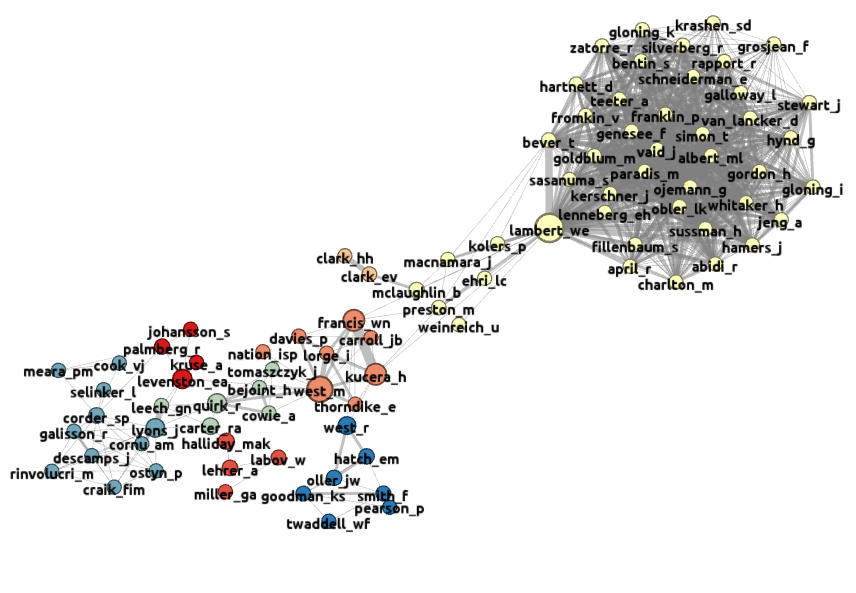 |
||
Lognostics Maps 1983 |
||

|
data source: VARGA 1983: data analysis: July 2015 data: 59 papers, 92 nodes, 801 co-citations, 8 clusters threshold for inclusion: Authors must be cited in at least three different papers. Co-citations occurring less than twice are excluded. Nodes are sized according to their betweenness centrality. 92 authors are cited in at least three of the papers in the 1983 data. This number is close to the conventional figure of 100 authors usually used for co-citation analysis. However, in order to reach these numbers, the threshold criterion has to set at a relatively low level.
Points to note in this map are the following: The map identifies eight clusters in the 1983 data. There are no disconnected clusters, but the map is clearly divided into two sectors with very different characteristics.
The large, densely connected cluster in the Northeast of the map is mainly concerned with the neurolinguistics of bilingualism. This is not an entirely new feature in the research: there were already some signs of interest in the psychology of bilingual speakers in the 1982 map, and this work persists into 1983. However, the very dense pattern of co-citations that appears in this cluster is a new feature.
As in 1982, the almost complete absence of nodes that identify modern vocabulary researchers is striking. The appearance of Paul Nation as part of the Word Lists and Frequency Counts cluster is worth noting, and there are some signs of a distinctively European approach to L2 vocabulary acquisition (Palmberg, Ostyn, Cornu, Galisson, Meara and Levenston). These authors are not co-cited to any great extent, though the cluster consisting of Palmberg, Levenston, Kruse and Johansson, who are all associated with the Interlanguage Studies Bulletin - Utrecht, suggests that the beginnings of systematic L2 vocabulary research might be appearing. Of some concern is the complete lack of co-citation links between the two sectors in the map. Generally speaking, the large neurolinguistics cluster is distinguished from the rest of the map by a reliance on experimental methods, and by an extended use of case studies. Work of this kind is conspicuously absent from the rest of the map. There are very few shared reference points between the two sectors - and these are all located in the Word Lists and Frequency Counts cluster. The two sectors of the map seem to use these reference points in very different ways: the neurolinguistics sector is mainly concerned with using these sources as controls for experimental studies, whereas the other sector is perhaps more interested in these tools as objects in their own right. Carroll and Richards, who were key links in the 1982 map, are both absent from the 1983 map. Instead, the common core which links the smaller clusters together in 1983 seems to be the emergent corpus linguistics and dictionaries cluster consisting of Béjoint, Quirk, Leech, Carter, Cowie and Tomaszczyk.
|
© 2015 Paul Meara